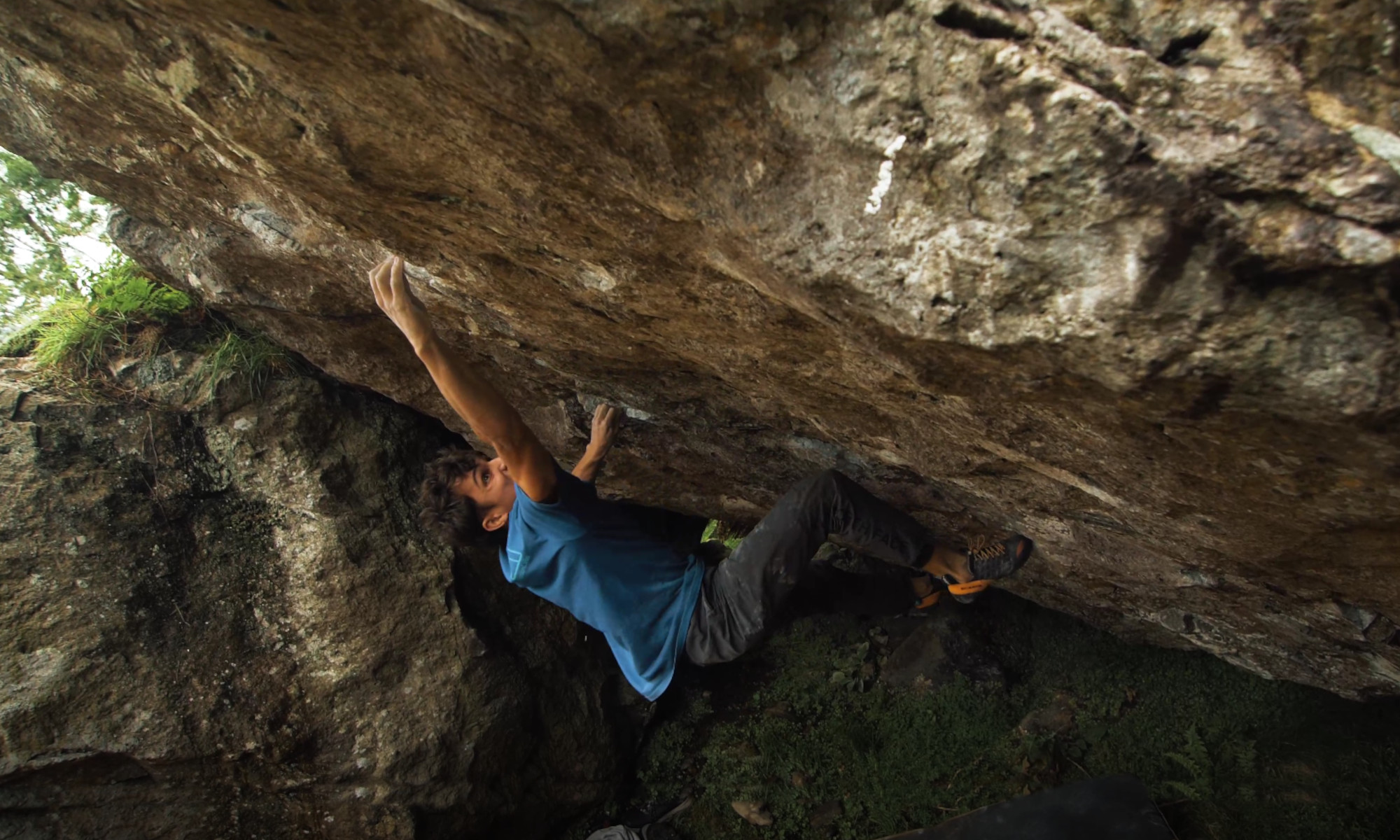I recently noticed that its been over 20 years since I started this website, March 2003 to be precise. As such I thought I’d take a trip down memory lane and re-post this article, first written back in 2003 by my old amigo Neil Kershaw. In retrospect it’s the perfect preamble to what followed, and what is now preserved in either my guidebook or the pages of this incarnation of LakesBloc.
A History of South Lakes Bouldering
By Neil Kershaw (first published March, 2003)
The Early Days
The early days. Flat caps and roll-ups give way to flares and afros, through bright spandex and shoulder pads until the start of the nineties. Throughout all this bouldering was largely ignored in favour of developing the bigger cliffs. North Lancashire boasted many keen climbers yet lacked crags of a sufficient height, however the many short limestone outcrops that dotted the region provided a good evening’s sport. In the absence of a bouldering culture these were often seen as micro-routes, but are undoubtedly of a bouldery nature. Fine examples are The Big Plum and Plumbline at Warton. Some definite problems did sneak through the net though, and The Answer and The Paradox of Woodwell provided both difficulty and an ‘old-skool’ nature – high, fingery, and quality lines.
Sports Day
“Practice makes perfect” – Mid-Eighties, and if you lived in the area and spent your weekends on the sports testpieces of Malham or Raven’s Tor, there wasn’t much of a workout to be had. With this is mind the modern day ethos of the area took root – difficulty for difficulty’s sake. Problems such as The Red-Dot Traverse 7A or more like F7c (Hutton Roof) and Tom’s Traverse 6C+/F7b at Woodwell courtesy of Tom Walkington must have seemed the product of a crazed mind to the old guard; both take a pointless line which in many places comes pathetically close to the ground and are harder than surrounding natural problems. On top of representing a conceptual leap in itself, the latter problem also provided a link to the next stage of development…
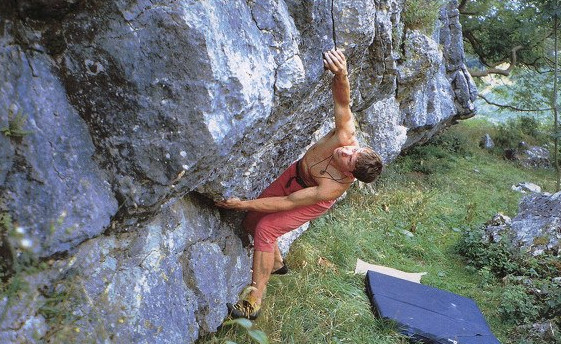
Cometh the Hour…
…for it was while spotting his brother on the problem in 1995 that the next player in our saga had a new vision of the future. The man was John Gaskins, and the future he glimpsed was short, steep, waist high…and covered in brambles. Extensive explorations over the Farleton plateau for the past year had yielded many still unrecorded problems plus the top-rope testpiece of Pandemonium 7C+ to him, but somewhere fresh was required. The roof beneath TT was the object of his desires, and that February saw evangelical gardening and an attempt at shifting the large blocks beneath the roof ;
“Three of us attempted to remove the block from below what is now Kaizen, by using a winching system rigged from the large trees near the fence – a procedure abandoned when the trees started moving, whereas the block showed no intention of doing likewise.”
– John Gaskins
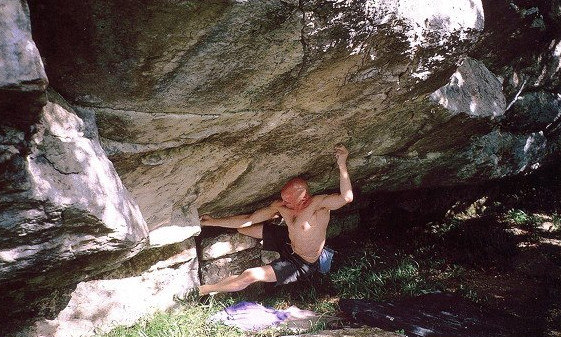
All clear and dry, and work begins. First to fall was the line that first caught his eye, Screaming Slave 7B+ and one of the best problems in the area. This heralded the arrival of ‘nu-skool’ style and difficulty to the area, and nearby The Art of Self-Destruction 8A from the same time was then one of the hardest problems in the country. The King of Skin 8A, a traverse of the blankest part of the roof hinted at greater things yet to emerge from this roof…
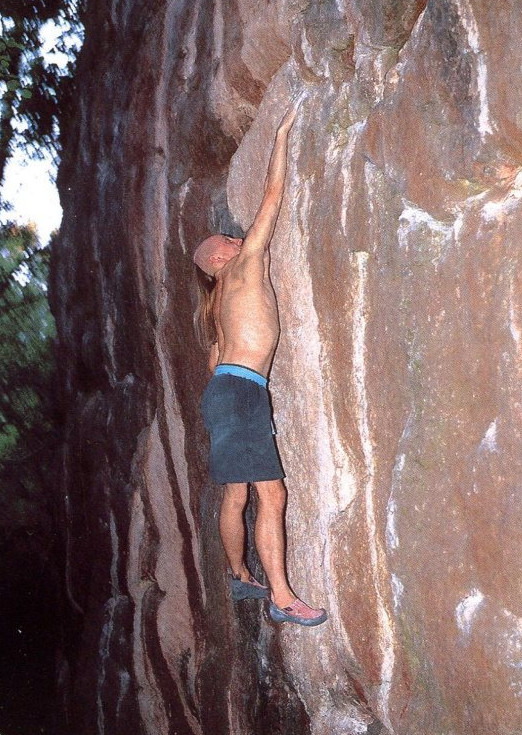
Counting Pixies
1996, and Gaskins recalls an early visit to Fairy Steps from way back in 1989. Perhaps a hazy memory of climbing slightly chossy routes whilst marvelling at the beautiful compact bubbly rock that formed a ‘less grand’ backdrop? Regardless, now it was in the foreground of his vision and a return visit confirmed the ideal bouldering potential. John was so taken he climbed and recorded all the present problems up to 7B, plus the Aeon Prow 7C being the highlight of difficulty.
A short interlude to Hutton Roof and Chimera 8A+ (which eliminates holds on the already eliminate Red Dot Traverse!) and we return to Fairy Steps in 1997. The crag classic The Trick was climbed at 7C+ in the crisp conditions. These days massive footholds have materialized on this problem and dropped the grade to 7A+, which although a shame at least gives most keen boulderers a crack at this quality line. Aeon L-R 8A was also climbed.
Beauty and the Beast
Still 1997 and the increasing development of the bouldering culture led to the availability of the bouldering mat. This few inches of foam must have been like a window to another world for Gaskins, and through it he saw the previously unclimbed gnarly blank white streak left of Essence Direct on Trowbarrow’s Red Wall materialize into the classic Shallow Grave 7A+. Recollections of a line in a similar style up at Farleton quickly produced the equally classic New Rose 7B+. These are both beautiful problems which are must-do’s for any capable visitor to the area.
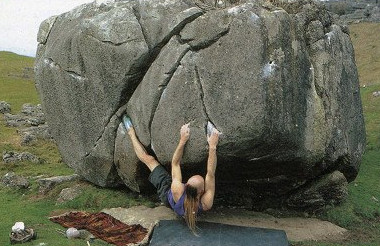
At the same time, Woodwell was still presenting challenges that had existed since its initial phase of development – the line up through the widest part of the roof, and logical start to King of Skin, completing a full traverse of this part of the crag. It was this second line that fell to give the desperate Cloning Technology 8A+, a ridiculous test of power-endurance with a depressing fingery crux to gain some hideous slopers coming after 30ft of slappy climbing through the horizontal. Suffice to say this took the new gold medal of difficulty for the area.
Smells Like Teen Spirit
Around late 1997 two local teenagers, Greg Chapman and Neil Kershaw, took an independent interest in climbing and were brought together by working in the same outdoor shop. Love of the outdoors and lack of money drew them away from the usual climbing wall route towards the local crags. Being too crap to do anything anywhere else Warton Pinnacle was the venue to be, where Greg in particular found his strength far exceeding the requirements of the classics and so produced the dynamic Beastmaster 6C+ and crimpy Totally Focussed 6C+. Both represented real quality and Greg’s eye for a line, which had by now become trained on the previously untouched Heysham Head boulders. This yielded the superb Stardust 7A but more importantly a keenness to develop and also document all the problems within a circuit, a sign of things to come from this pair…
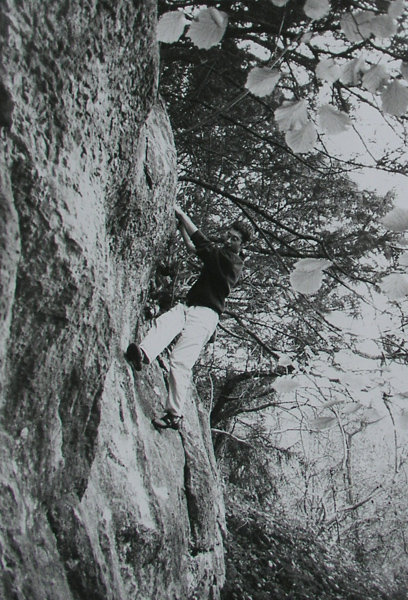
Gene Therapy
Meanwhile Gaskins was taking advantage of the newly tidied Trowbarrow Quarry (as it became a Nature Reserve), in which the access to the huge boulder on the quarry floor became easier. Atrocity Exhibition 8A , though of no particular importance apart from the obvious difficulty, has been the cause of controversy because of its ‘chipped’ sidepull. This actually resulted from the contractors tidying efforts, and not from the end of a chisel. The sit-start to problem 2 [Free Hang SDS] 8A was also done.
Gaskins also climbed his previous Fairy Steps traverse Aeon there and back again at 8A+/8B. While not being a particularly obvious or classic problem, it did represent a new level of difficulty and indicated what Gaskins was capable of…
Sometime in between now and April 1999 a car speeds down the road between Warton and the Yealands, as many cars are wont to do. But this one contained the ever keen Gaskins eye in the passenger seat, and through the trees and beyond the ever-present dog walkers he spied one of the areas classic problems. Transgenic; a low-slung traverse line on rock of the utmost quality; sculpted slopey limestone crimps contain the blueprint for a crescendo of brilliantly technical moves as the pump increases. As possibly the best 8A hereabouts it still awaits a recorded repeat, but will surely become the hard classic of the area.
Seepage Holiday
As with most Northern winters, that of 1999 was shocking. The local limestone favourites seeped terribly and no real substitutes existed for when the odd fair day did occur, bar Heysham Head, which had by then been done to death by Chapman and Kershaw who developed everything sub 7C now present. Until now. The new Lancashire guide revealed the presence of local gritstone, Thorn Crag. Still keen for rock and with a newfound thirst for grippy brown route, Kershaw took the long walk to check out the crag’s bouldering potential.

Once again the old guard had in their haste to do routes (albeit excellent) walked straight past an amazing little bouldering sector. A visit with his mum’s yard brush drew some funny looks from the local yokels but helped clean the problems and amongst others the mid-grade classics Burnt Heather 6A and The Latest Trick 6C were done. Further investigation found other boulders here, but these had to wait for Greg Chapman to visit the crag.
Also undeterred by the seepage, Gaskins turned his hand back to the Trowbarrow Boulder (which takes little). The cool crisp winter conditions proved the key to latching the awful crux pinch on the steep northwest arête, and a new crown of difficulty had to be found for Isla de Encanta 8B. Certainly the hardest bloc problem around, possibly throughout the whole country. Incidentally it was the (albeit limited) publicity that this problem received, both from OTE magazine and bouldering film Stick It that provided the catalyst for increasing interest both in the area and in Gaskins.
Disco 2000: Bustin’ New Moves
A new millennium, and once again the story is of the development of a new area from Chapman and Kershaw, and the surpassing of previous limits of difficulty from Gaskins.
Years of hunting for virgin rock had instilled in Kershaw a nose for new crags. Noticing that crags tended to come in long edges, what lay hidden in the trees over the road from Woodwell? Woodwell O’ert Road, that’s what (!). Although visited before by Dave Bates and Mr. Gaskins at least, no lines were climbed due to lack of official access. Youthful disregard for potential trespass and an initial sessions climbing from the young pair produced Greg’s area classics Angel Deelite 7A and Superstar DJ Tinpot Todd 7A, along with a recognition that they were onto something special. Greg soon had the access sorted but no new lines were attempted due to blatant lack of ability.

Thankfully they remained to be taken on another day as Gaskins had other ideas…Although Cloning Technology already traversed the roof left to right, there was an arguably more logical start even further left which would give the longest trip through the roof. Coming out the other end would normally be in doubt given as the previous 7A start into the remaining 8A’s worth of climbing was now replaced by a desperate 7B+, but not for Gaskins who choose to use a much harder eliminate version of the crux on his ascent! Whatever tickles your fancy – this alternative version represents a solid 8B.

It turned out to be a warm up. Such obvious good form was now applied to the stunning lip traverse of the lone buttress at the far end of Woodwell. Heavily bulbous like the fat lip you might get in a punch up, the holds weren’t up to much either and sustained slapping between them sometimes led, arms acid-washed, to the easier second half. This was reached a few times before the eventual ascent. Initially given 8B+, a repeat by route technician Ian Vickers dropped the grade to 8B (in his words “like redpointing an 8c+ route”), but for sure this combined quality rock and desperate climbing of the highest order like nothing else in the region. Other 8A’s to get mopped up were the poster-perfect Shallow Groove [now considered 8B] and the Cringlebarrow Traverse – Curtain Call.
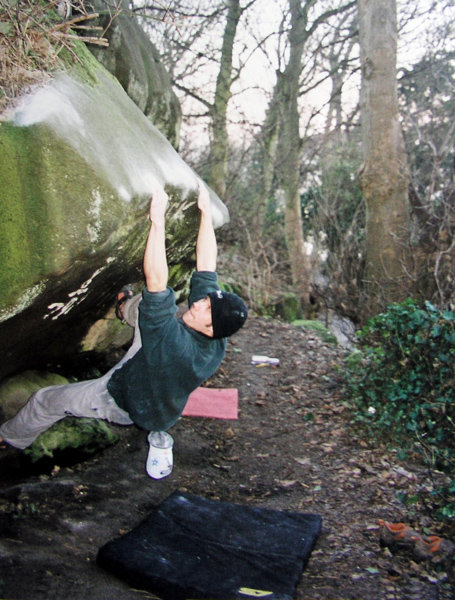
The Same Old Song, 2001
First the development; Chapman took up where Kershaw had left off up at Thorn Crag. The outlying areas of Trackside and Seaview were laboriously cleaned and alone he developed every problem there, and once again they were all recorded for the benefit of others and publicized in OTE. Highlights were Resistance is Futile 7A and the superb Mothership Reconnection 7A+, this latter proving that Greg can find a cool problem anywhere! Further proof, if it were needed, came with the blatantly obvious Boogaloo Shrimp 7C at Heysham (inset). The ultimate sloper traverse, it cried out to be climbed! Chapman didn’t have it all his own way though, Kershaw came back from a long trip to America and injury straight to O’ert Road. An afternoon saw the obvious central line of Turbulence 7C despatched. Cleaned by hand (literally, no brushes!) and climbed with much lichen under the fingernails, the lack of a mat lead to a hairy moment (or five) upon reaching the break. This being were most problems finish, the first ascent was in the bag, but getting back to ground level wasn’t as clear cut as the jump down onto the bare rocky landing (then much worse) didn’t appeal. A desire to top out direct over the upper roof was eventually abandoned in favour of swinging out right and topping out Angel Deelite…
Second the hard stuff; Gaskins was quietly turning his backwater playground into a national forcing ground for difficulty – remember the last remaining line at Woodwell, the largest, blankest part of the roof? This now became Kaizen 8B+, the hardest bloc problem in the country [at the time] and arguably the first time for about a decade that British bouldering had caught up with the rest of the world. But 8B+ isn’t everything, quality still counts for something and this niche was smartly filled by Walk Away at Fairy Steps. A sheer 10ft of the most beautiful crozzly limestone in existence was marred only by its unusually uniform blankness. While most people would take a bow to Mother Nature and move on, Gaskins pinched the hell out of an imperceptible ripple and somehow reached the slopey break to create what is certainly one of the hardest single moves in the world- 8B.
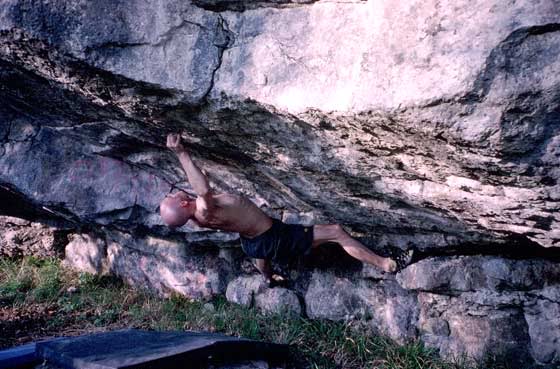
Keeps on Walking
2002 arrives and still the record is stuck. Chapman goes to check out the previously developed Little Font in Kentmere only to find some excellent problems inadequately served by the topo. New problems added (as per usual!), such as the classic Negative Reality Inversion 6C+, and the topo was revamped and made available.

Meanwhile Gaskins can no longer resist giving Heysham Head a try (despite Greg’s tip-off being years old!) and came away with the outstandingly obvious lines of Atomic Garden and Boogaloo Shrimp sans footblock both 8A and rounding off development of this neat little place. Back on the limestone the further tit-bit of the un-named roof right of Angel Deelite [Back-Hand Roof] at O’ert Road went down to some dismaying ceiling gymnastics at an unlikely 8A (very unlikely if you ask me!). Fairy Steps still held a strange attraction though, and crisp autumn conditions allowed the rib right of Walk Away to propose an Axiom 8A+, a problem well worth waxing lyrical about both in terms of aesthetics and difficulty. Yet its hard to call it difficult when compared to what was about to transpire next door.
As a man with an obvious long term vision and limitless project patience, Gaskins decided to have a dabble on the sit-start to his desperate 8B wall, Walk Away. A few small but positive crimps low down encourage the casual onlooker, and indeed it isn’t beyond most strong boulderers’ imaginations to pull on. The problem comes when encountered with the utterly pathetic split-fingered excrescence of the original stand-up, which now as to be attained, hung, matched, then squeezed. Nominally 8A just to get into the stand-up, the full link is tentatively graded 8C and thus stands as one of the hardest problems in the world and one of the finest achievements ever on British rock.
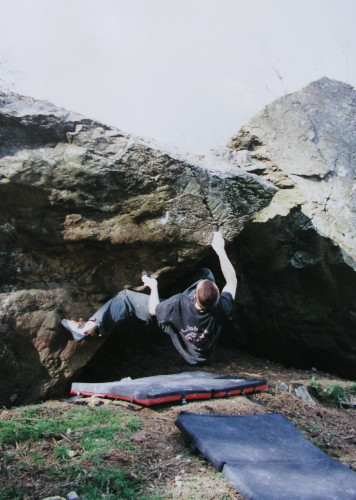
The Present Day…
So we come to 2003. Already this year Chapman has been up to his old tricks, revisiting Kentmere to discover the immaculate Garburn Pass boulder with its spread of excellent mid-grade lines, and the nearby Valley of the Kings and Tongue Scar boulders. Together these provide a mature area for the Lakes boulderer. St Bees also fell under his watchful eye and has thus far yielded some real plums of all grades and should continue to do so for some time. That’s not to mention his excellent new venue in the central Lakes.
Gaskins also got a predictable look in when he took time out from his Raven Tor project to produce the full traverse link of Woodwell O’ert Road as Hybrid Moments 8A. A quick repeat from Kershaw, who also made the second ascent of Cloning Technology earlier in the year; hopefully more ascents of this and the area’s other hard classics will follow in the coming years. Only time will tell…
The Future [2003>]
Check out the wall right of Atrocity Exhibition on the Trowbarrow Boulder, or the roof left of Lilypond Walk at Woodwell, or the sitter right of Yatsufusa at Thorn Crag, or…
Thanks to John Gaskins for his information.
